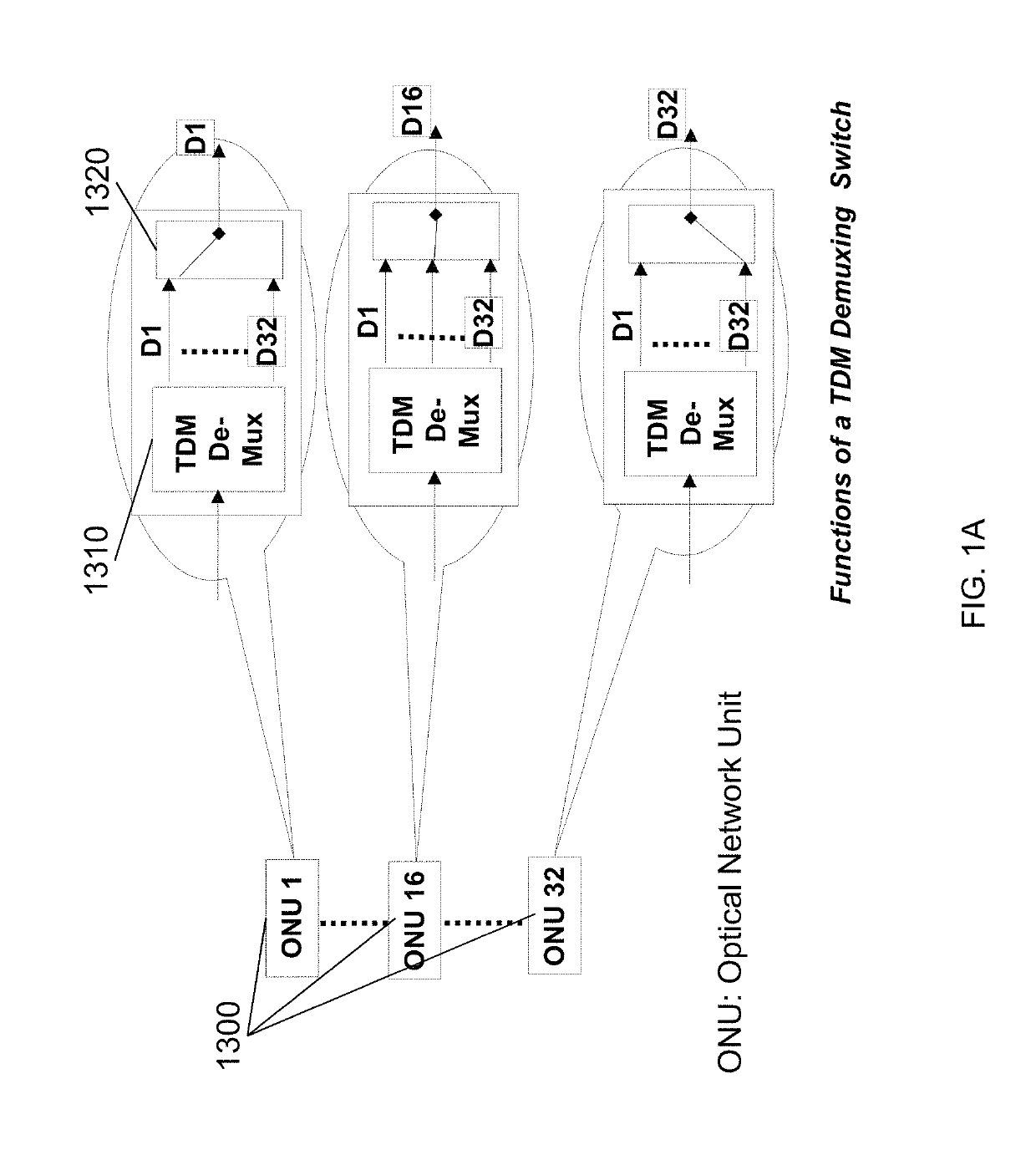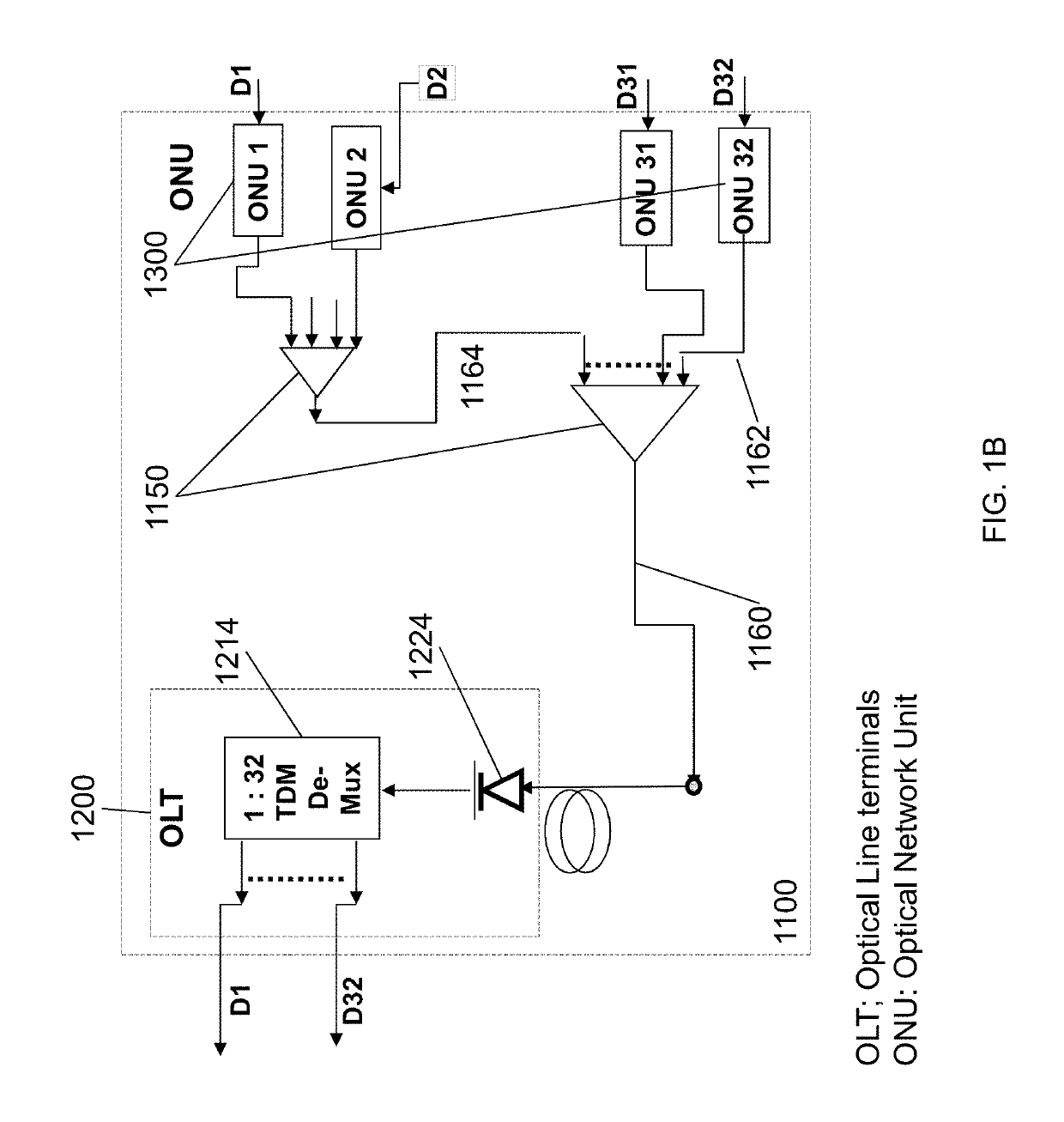Ground terminals via remote digital-beam-forming networks for satellites in non-geostationary orbit
a satellite and satellite technology, applied in multiplex communication, power management, wireless communication, etc., can solve the problems of increasing complexity, increasing the cost of small cell backhauling deployments using existing infrastructure, and increasing the difficulty of satisfying this requirement, so as to improve privacy and survivability in data transport, the effect of increasing the data rate to subscribers and increasing the data ra
- Summary
- Abstract
- Description
- Claims
- Application Information
AI Technical Summary
Benefits of technology
Problems solved by technology
Method used
Image
Examples
embodiment 1
[0097]FIG. 2 depicts a PON 1100 connected to a user processor 2100 for a second user through one of the ONUs 1300, the ONU 2 designated as for a second user with a designated data bit stream D2. The user processor 2100 comprises a router 2110 which is connected to a picocell hub 2120 for cell phone wireless connectivity via a picocell hub antenna 2232. Cellphone 2236 can be operational within the antenna coverage or field-of-view (FOV) 2234. Picocell is also referred as small-cell. The router 2110 may also be connected to WiFi hub 2130 for wireless connectivity via a WiFi hub antenna 2132 for many personal devices 2136. A notebook as one of personal devices 2136 may connect to Internet when it is within the FOV 2134 of the WiFi hub antenna 2132.
[0098]Referring to FIG. 2, each of the optical network units 1300 (ONUs) is arranged between one of the optical dividers 1150 and a corresponding one of thirty-two user processors 2100. In the downstream direction, each of the optical network...
embodiment 2
[0100]FIG. 3 is a down link or a forward direction schematic diagram showing a passive optical network (PON) 1100 in combination with wave-front multiplexing (K-muxing 130) and WF demultiplexing (K-demuxing 140) techniques for dynamically allocating the resource of the passive optical network system for multiple user processors 2100 according to an embodiment of the present invention. We shall refer to the K-muxing 130 in a preprocessor and K-demuxing 140 in post-processors. They are new functions in conjunction with a PON 1100 in this patent application. In short the K-muxing 130 before OLT 1200 in a pre-processor 1800 and the K-demuxing 140 after ONUs 1300 in post-processors 1340 in forward direction may be referred as new or additional functions for the OLT 1200 and the ONUs 1300. These new functions may be implemented by additional S / W and / or electronics boxes in the OLT and the ONUs. We referred this architecture, a PON in a combination of K-muxing 130 and K-demuxing 140, as “K...
embodiment 3
[0125]FIG. 4 depicts the same functional blocks as those in FIG. 2, except in the user side. The updated user processor 3100 comprises two smart array antennas; a first one for picocell hub 2110 and a second one for a WiFi hub 2130. The picocells are also referred to as small cells. Four antenna array elements 2232 for the picocell hub 2120 are connected to a device for function of digital beam forming (DBF) 3120. A first smart array is formed by the 4 elements 2232 and a first one (DBF 1) of the DBF 3120 for the Picocell hub 2120.
[0126]The first smart array shall operate on a cell phone band, connecting multiple cell phones 2236 to the picocell hub 2120 concurrently over a common field of view 2234. The smart array may form concurrent tracking beams with orthogonal beam patterns. For three cell phones 2236, the smart array shall automatically form three concurrent beams. The first beam shall be dynamically optimized following current position of a first cellphone with a beam peak a...
PUM
 Login to View More
Login to View More Abstract
Description
Claims
Application Information
 Login to View More
Login to View More - R&D
- Intellectual Property
- Life Sciences
- Materials
- Tech Scout
- Unparalleled Data Quality
- Higher Quality Content
- 60% Fewer Hallucinations
Browse by: Latest US Patents, China's latest patents, Technical Efficacy Thesaurus, Application Domain, Technology Topic, Popular Technical Reports.
© 2025 PatSnap. All rights reserved.Legal|Privacy policy|Modern Slavery Act Transparency Statement|Sitemap|About US| Contact US: help@patsnap.com



